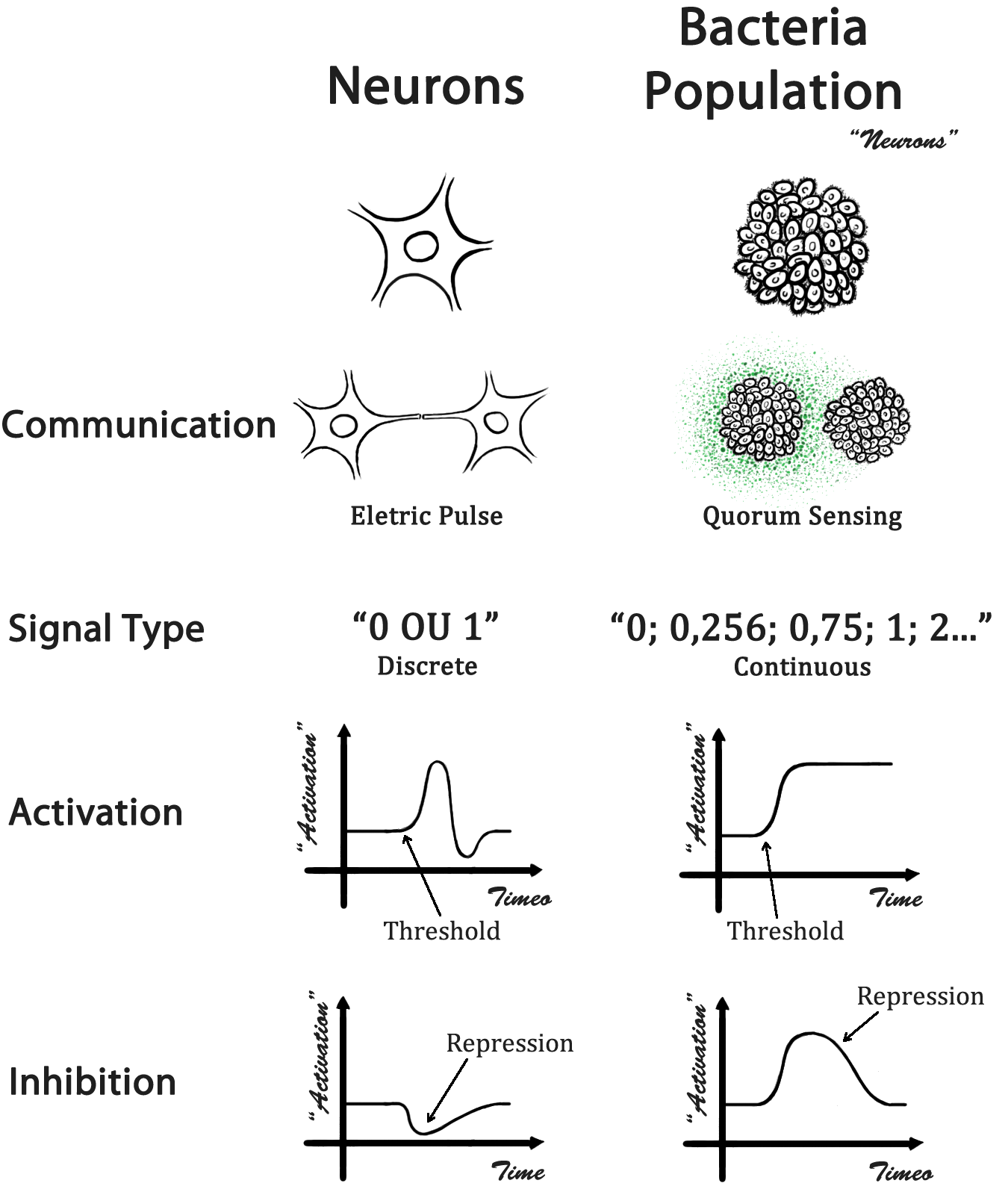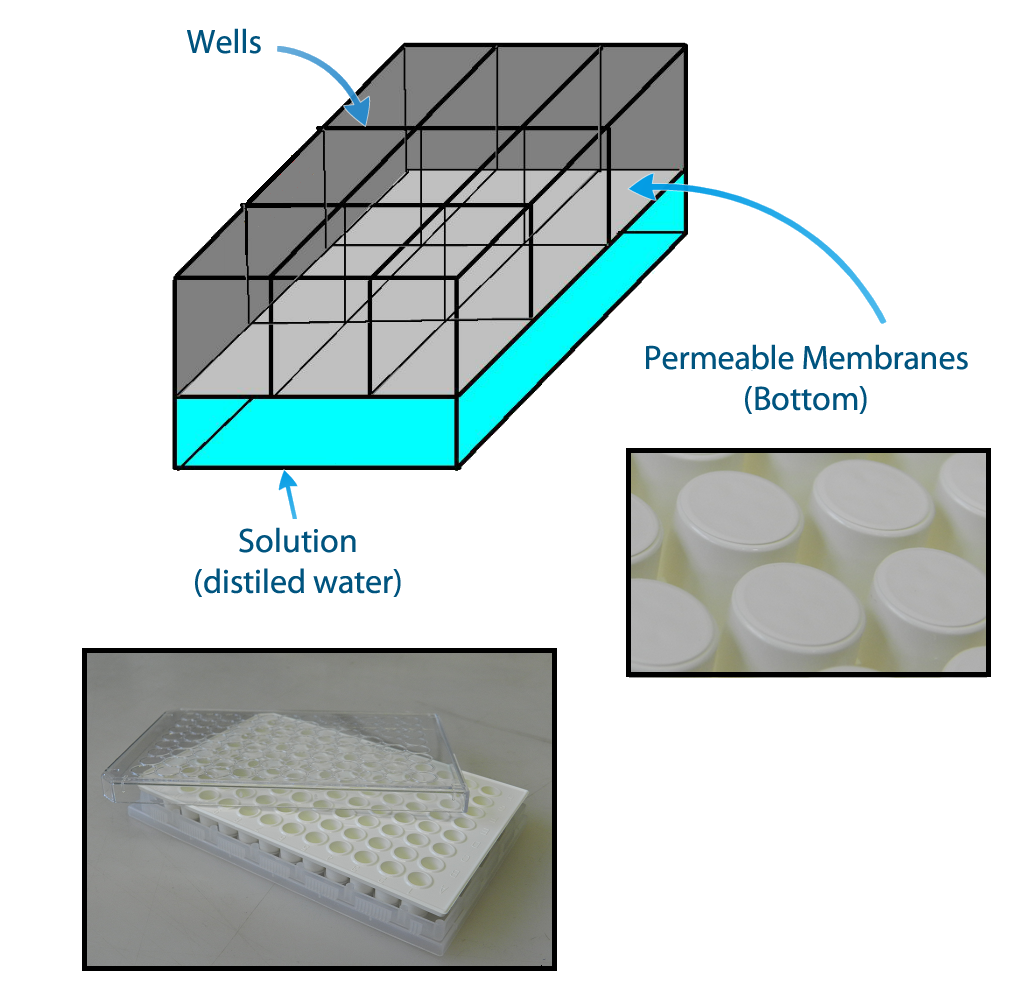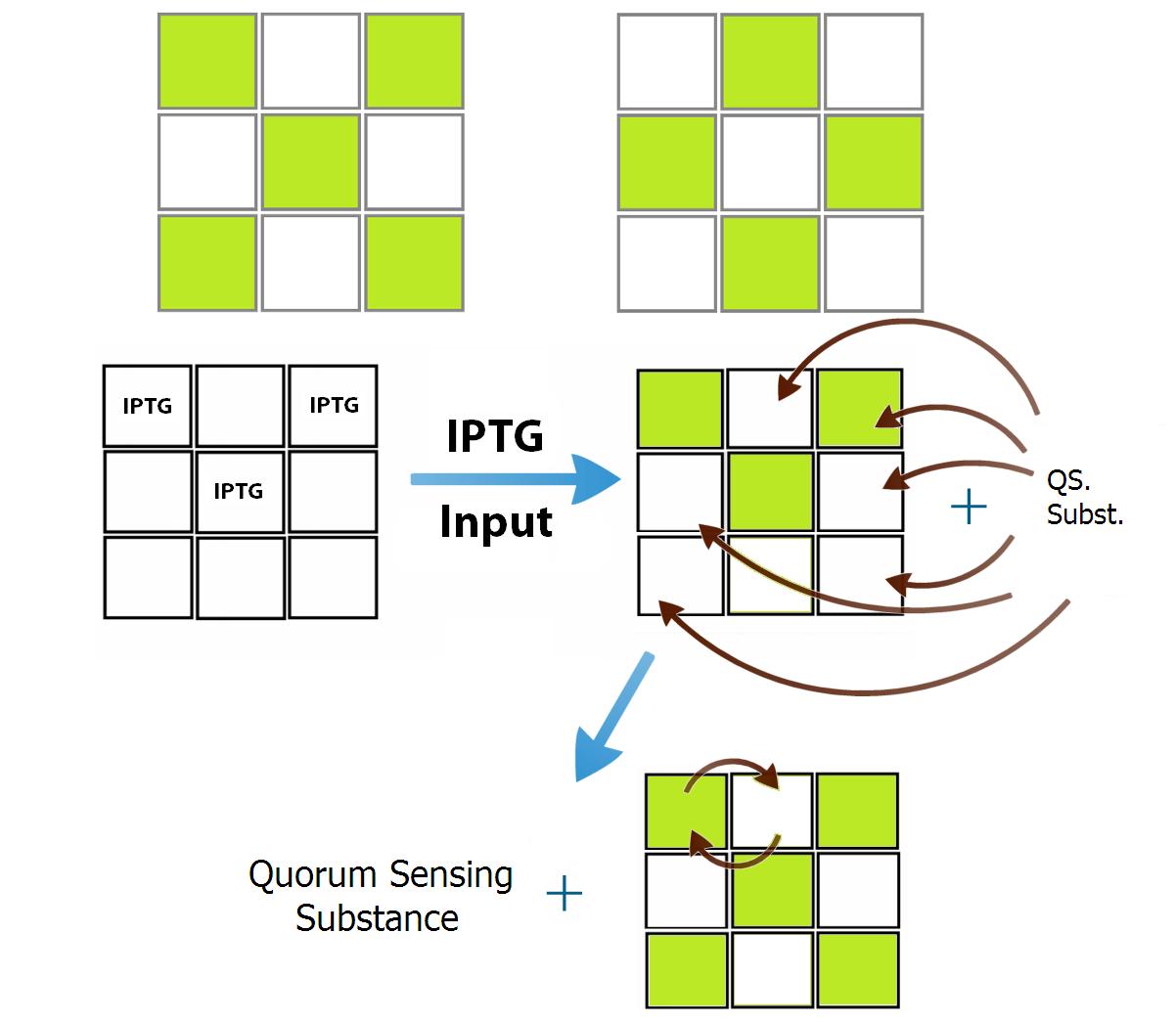Team:USP-UNESP-Brazil/Associative Memory/Background
From 2012.igem.org
(→Hopfield Associative Memory Networks) |
Carloshotta (Talk | contribs) (→Genetic Construction) |
||
| Line 61: | Line 61: | ||
Initially,we intended,– only as a concept proof - to create a network associative memory for discrimination activation patterns between the "L" and "T", similar to the one presented in Figure 2. As these memories require that all points of the network have a communication singular, we searched for a case in particular that demanded that memories would require only a small number of quorum sensing substances. | Initially,we intended,– only as a concept proof - to create a network associative memory for discrimination activation patterns between the "L" and "T", similar to the one presented in Figure 2. As these memories require that all points of the network have a communication singular, we searched for a case in particular that demanded that memories would require only a small number of quorum sensing substances. | ||
| - | + | Asymmetrical memory would be the answer: since only two quorum sensing systems are necessary to accomplish the same recognition memory task as an incomplete memory, similarly to the example showed in Figure 2, the "X" and "O" memories. In these patterns there is no intersection between "letter X" and letter"O”, which greatly simplifies the configuration of communication weights between positions (see Figure 5). Because each position of the “X” inhibits all positions of “O” and activates all positions of its own pattern (and vise-versa), there is no need to distinguish between the kind of signal (quorum sense substance) that each position of the “X” emits. The same works for all positions of the “O” pattern. Still, the positions of each pattern can be programmed with the same genetic code, which allow us to use only two systems of quorum sensing to create a network of associative memory that is capable of differentiate between two memories, given a particular input that would be interpreted as an incomplete memory. | |
[[File:0019.JPG|center|500px|caption|]] | [[File:0019.JPG|center|500px|caption|]] | ||
Revision as of 15:35, 25 September 2012
 Introduction
Introduction Project Overview
Project Overview Plasmid Plug&Play
Plasmid Plug&Play Associative Memory
Associative MemoryNetwork
 Extras
ExtrasHopfield Associative Memory Networks
The main model of the project is the associative memory network made by J.J. Hopfield in the 80’s. On this model, the system tends to converge to a pre-determined equilibrium, restoring the same pattern when exposed to variations of this same pattern.
The architecture, or geometry of the system, is composed in a way that all neurons are connected .In math terms, a Hopfield Network can be represented as an “Energy” (E) function:
Where “w” values are chosen such that the stored settings are the minima of the function “E”. The variable “x” is the state of the neuron “i”.
The state of a given neuron “I”(active or silent) can be mathematically represented as follows: Given that “xi“ is the state of neuron, 1 if is activated or 0 if silent, and a neuron turns active if the sum of all received stimulus (exciting or inhibiting) is more than 0. Mathematically we can represent the state of the neuron xi as:
In this equation, “wij” is the wheight
Where "wij" is the weight assigned to the connection from neuron i to neuron j. The summation over j is the sum of all connections made by the neuron i. This dynamics (equation 2) is sufficient for the network to converge the most similar memorized pattern.
The so called “learning” of a neural network consists on the choice of “w” weights. There are several ways to choose them, what, actually, defines different learning methods
Set "i" and "j" such as the wheight "wij" is defined as:
The Figure 1w shows the selection process of weights of connections between adjacent cells. To add more patterns, we have to sum the network of weights of the new pattern to the old network. (as shown in the Figure 2)
"Figure 1"
The Hopfield model for the construction of an associative memory network using bacteria is a good choice because of its simplicity and strength. The same methodology can be used to the construction of networks with other architectures, such as the “perceptrons”. One step forward is the way how to deal with continuous biological variables, because the standard model uses discrete ones.
"Figure 2"
Biological Mechanism
In a neuronal communication system, the cells of the network occupy a specific place of space and the information is addressed through a direct physical contact - the neuron axonal projections. To replicate this in a cell system that moves constantly it would be also necessary some way to specifically address the information flow between the system’s components, otherwise it will not be possible to attach a meaning to a communication without specificity.Furthermore, is possible to verify the neuronal activity[1.4] because of the fixed spatial position of the cells, which conserves the signal observation of a neuron in a specific local.
It’s much more complicated to observe the dynamics of this cell communicating system using bacteria. Unlike static single cells communicating with each other (see figure 3), we aim to observe the communication between many genetically distinct bacterial populations. And these cells don’t stop moving! In other words: there’s no specific point in space which can be always observed the same phenomenon.
"Figure 3"
To solve this information addressing problem, it would be necessary that each bacterial population (like neurons) communicate with themselves in a unique way so a receiving signal can be distinguished between populations. We chose the quorum sensing (QS) communication mechanism for this task, using different quorum systems for each “point” (population) in the network. With different QS molecules, it’s possible to build a communication system with unique signals like neurons in a network, where the information addressing specificity is present by the axonal ligation.
Therefore, the influence of inhibition or activation that one point of the network can have under another in the bacterial system would be given by the particular meaning of each signal for each cell population – this point is where the memory programming of the system occurs which is the determination, for each cell population, the meaning of each communication signal of every point of the network.
Then, to solve the problems of the visualization of the signals’activation, we planned the construction of a device to make 9 E.coli populations to communicate with each other but still keep their position in space. As an improvement to the example in figure 1, the device enables the communication not only of neighbors but also of all the populations, inhibiting or activating them according to the memory implanted to the network. This way, comparing to the communication between neighbors and of the whole system itself, generates a bigger resolution of the output in response to a similar input, once each position has better information about the pattern of activity of all the other positions. Figure 4 shows a construction of the system that can enable an efficient communication between the populations of different positions of the network, even if it is physically separating them.
"Figure 4"
The device can be easily constructed using a plate of 96 wells with membranes attached to the bottom. The membranes will allow the diffusion of the quorum sensing substances and prevent the flux of bacterial populations between the wells; avoiding, them the mixture of the activation signals (outputs).
Genetic Construction
Despite the solution we found to the specificity of the communication, another problem appears when we try to genetically build the bacterial populations: there are not enough quorum sensing systems to create 9 bacterial populations with different ones. In the Registry of Parts there are 4 quorum sensing systems well characterized, and there is a strong activation crosstalk between two of them (Las and Rhl), this fact prevent us from using them, therefore, we end up with 3 systems of quorum sensing that can be used.
Initially,we intended,– only as a concept proof - to create a network associative memory for discrimination activation patterns between the "L" and "T", similar to the one presented in Figure 2. As these memories require that all points of the network have a communication singular, we searched for a case in particular that demanded that memories would require only a small number of quorum sensing substances.
Asymmetrical memory would be the answer: since only two quorum sensing systems are necessary to accomplish the same recognition memory task as an incomplete memory, similarly to the example showed in Figure 2, the "X" and "O" memories. In these patterns there is no intersection between "letter X" and letter"O”, which greatly simplifies the configuration of communication weights between positions (see Figure 5). Because each position of the “X” inhibits all positions of “O” and activates all positions of its own pattern (and vise-versa), there is no need to distinguish between the kind of signal (quorum sense substance) that each position of the “X” emits. The same works for all positions of the “O” pattern. Still, the positions of each pattern can be programmed with the same genetic code, which allow us to use only two systems of quorum sensing to create a network of associative memory that is capable of differentiate between two memories, given a particular input that would be interpreted as an incomplete memory.
"Figure 5"
We decided to use two of the four available quorum sensing systems that have substances different enough for the bacterial communication so there would be little cross-talk between them. The quorum sensing systems chosen were Cin and Rhl[1,16].
To convert the signals in activation or inhibition, we created a system of transduction of the quorum sensing signal to transcription of an activator or an inhibitor of the transcription of GFP, this will be our system activation reporter. Simultaneous inhibitions and activations of a bacterial population will be converted to a molecular competition of activators and inhibitors by the promoter that controls the production of GFP. It is this molecular competition that promotes the decision between the memories of the communication systems, associating a given input with a more similar memory. As an example, if an input activates more positions of the “X” pattern than the “O”, the competition in the pattern “X” positions will be more favorable to its activation due to the greater number of activators produced by the activated positions, while in the positions of the “O” pattern the opposite occurs, because of its small number of positions activated initially by the given input.
The promoter multi-regulated by an activator and an inhibitor is called Prm. Its inhibitor is the transcriptional factor cl434 and its activator is the cl factor. The genetic design of the positions of the patterns “X” and “O” can be seen in Figure 6.
The construction using the signal transduction containing cl434 and cl allows creating different systems of associative memory, limited only by the quantity of quorum sensingsystems available. Figure 6 shows how this generic system would work and elucidates how this system could be applied to different functions involving a genetic control.
"Figure 6"
 "
"















